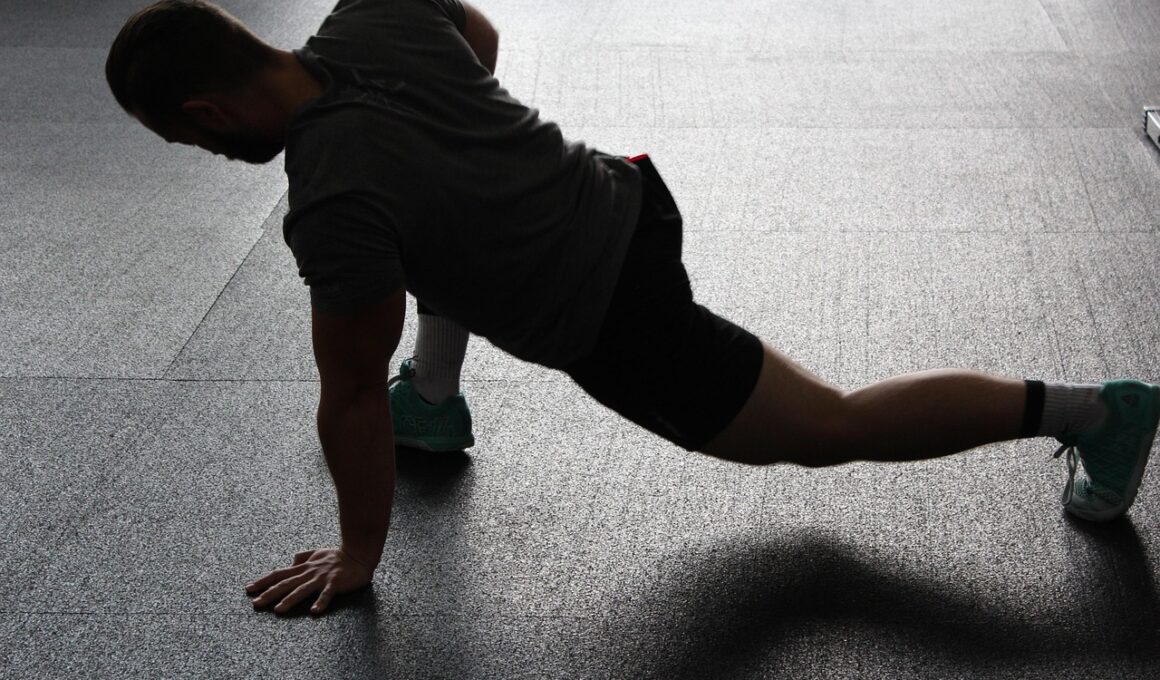Beginner’s Guide to Outdoor Warm-Up Exercises
Outdoor workouts have become increasingly popular among fitness enthusiasts looking for fresh and invigorating ways to stay active. Among these workouts, warm-up routines are crucial for preparing your body for exercise. Engaging in an effective warm-up enhances flexibility, reduces the risk of injury, and improves overall performance. When performing these exercises outside, you can enjoy the benefits of fresh air and natural light while energizing your spirit. Always prioritize the alignment of your exercises with your personal fitness level, ensuring a gradual inception into more intense activities. Start by incorporating dynamic stretches such as leg swings and arm circles, which are effective for loosening up tight muscles. Gradually elevate your heart rate with low-impact activities like jogging in place or brisk walking. Remember, an ideal warm-up should last at least 10-15 minutes. Incorporate movements that reflect the exercises you plan to undertake to activate relevant muscles effectively. As you progress, pay attention to your body’s response and adapt your warm-up routine to meet your needs. Through consistency and dedication, you’ll establish a solid foundation for a fruitful outdoor workout experience.
Research shows that warming up before any physical activity can enhance performance. Hence, being well-informed about outdoor warm-up routines is absolutely essential. Start by assessing your environment. Find a safe space free of obstacles, and ensure the weather conditions are appropriate for exertion. In cooler temperatures, prioritize warming up your muscles effectively to prevent injuries. Incorporate a combination of dynamic stretches and mobility exercises that can prepare your joints. Focus on areas that are vital to your workout, such as your hips, shoulders, and legs. Perform moves like lunges with a twist or high knees to improve flexibility and range of motion. Don’t hesitate to incorporate static stretches after your workout for muscle recovery. Consider using props like resistance bands to deepen stretches and promote strength in specific areas. Importantly, listen to your body and modify exercises if discomfort arises; this ensures a safe and enjoyable experience. In addition to physical benefits, warm-up routines help foster a focused mindset, allowing you to channel your energy intentionally towards your fitness objectives, thus reaping greater rewards from your outdoor workouts.
Essential Warm-Up Exercises for Beginners
When embarking on your journey to outdoor workouts, incorporating basic warm-up exercises is vital. These foundational movements will help enhance your performance while minimizing injury risks. Begin your warm-up with gentle movements, like arm circles and ankle rolls, letting your body ease into the routine without strain. Transition into dynamic stretches that mimic the movements you’ll perform during your workout. For instance, leg swings help loosen your hips and activate your legs, while torso twists engage core muscles. Moreover, adding in lower-body exercises like walking lunges not only warms up your legs but also builds strength. Gradually introduce light cardio, such as butt kicks or side shuffles, to increase your heart rate. As you progress, develop your routine based on the specific outdoor activities you plan to engage in. Engaging in a variety of movements ensures you warm-up all essential muscle groups and can prevent muscle fatigue later. Finally, stay hydrated before beginning your exercises, as proper hydration can significantly enhance your overall athletic performance.
Another crucial aspect to consider is timing when executing your warm-up routine. Ideally, you should aim for a duration ranging from 10 to 20 minutes. Allow yourself enough time to give your body a thorough warm-up. Spending less time than necessary may not be effective and could increase injury risk. As a beginner, keep your routines simple and easy to remember, helping you build confidence in your workouts. You can also track your time using your watch or fitness app to ensure you aren’t cutting your warm-up short. Focus on always keeping your movements controlled and deliberate rather than rushing through your routine. In addition, structure your warm-up routine around your fitness goals. If you’re preparing for a gentle jog, ensure less strenuous warm-up moves, while more intense sports like cycling may require thorough joint mobilization. Above all, use this time to connect with yourself, grounding your mind to the task ahead, and setting a focused and positive tone for your workout, ultimately enhancing the overall experience.
The Importance of Breathing During Warm-Ups
Breathing plays a pivotal role in your warm-up exercises. Proper breathing techniques help improve oxygen delivery throughout your body, enhancing both flexibility and endurance. Inhale deeply through your nose, filling your lungs entirely, and exhale through your mouth to release tension. Synchronizing your breaths with your movements can significantly increase energy levels and make your warm-up feel more enjoyable. Aim for a rhythmic pattern, matching your breathing to the pace of your exercises. For example, inhale when extending upward and exhale when contracting down. This general approach applies to stretches, lunges, or any dynamic movements effectively. Conscious breathing can also cultivate a sense of mindfulness. Focusing on each inhale and exhale can help reduce anxiety and create a calm space as you prepare for your workout. Moreover, effective breathing promotes better oxygenation of the muscles, enabling them to perform optimally. As you become more familiar with warm-up routines, practice integrating breath control. Over time, these habits will lead to better physical performance during outdoor workouts, aligning your body and mind in pursuit of your goals.
To maintain motivation and consistency in your warm-up exercises, establish a routine that works well with your lifestyle and available outdoor space. By introducing variety into your warm-up, you’ll stave off boredom and maximize the benefits of your workout. Trying new exercises can make outdoor warm-ups feel fresh and exciting. Consider incorporating interval training elements into your warm-up, alternating between various movements to keep things interesting. For example, you could alternate between jumps, stretches, and light jogging, gradually increasing the intensity. Additionally, consider warming up in a group setting; this fosters camaraderie and friendly competition, ultimately motivating you to commit to your fitness goals. Utilize local parks or community classes to find partners for accountability. Moreover, believe in setting personal benchmarks to help gauge your improvement over time. Tracking progress can reinforce positive habits and encourage continued efforts beyond outdoor warm-ups. Ultimately, developing an enjoyable warm-up routine enhances your commitment to maintaining an active lifestyle now and in the future, ensuring your personal growth within outdoor fitness endeavors, making exercise a rewarding part of your daily routine.
Conclusion: Embracing the Benefits
In summary, outdoor warm-up routines are essential for every beginner striving to maximize workout benefits while minimizing injury risks. It’s critical to prioritize the right movements to ensure preparation. Emphasizing the significance of breathing, being aware of timing, and introducing variety into your warm-ups contribute to a more positive experience. As you develop your routine, remain adaptable to your specific needs and preferences, ensuring that each warm-up session remains effective and pleasurable. By creating a warm-up routine tailored specifically for you, you lay the groundwork for sustainable outdoor workouts. Persistence in this practice fosters remarkable advancements over time, leading to increased strength, improved stamina, and heightened enjoyment in exercising outdoors. Remember to place just as much importance on your warm-up as you do on your primary workout. When executed well, warm-up routines set you up for success, ensuring that you can make the most of each outdoor fitness session. So, lace up those shoes, step outside, and embrace the vast world of outdoor workouts while enjoying all the benefits they represent!
In conclusion, implementing effective warm-up routines is of utmost importance. Whether you are beginning your fitness journey or looking to refine your outdoor workouts, the above guidelines are designed to help you succeed. Mastering these routines not only enhances your overall experience but also lays the foundation for effective practice. Enjoy the outdoors and the thrill of a well-executed warm-up!


